
I wonder, is your setup like mine? The answer is probably not. Not unless your home is more than 100 years old, has steam heat requiring 2-inch pipes crisscrossing below the 2 ¾-inch floor joists and has a main beam which is a rough-hewn square log.
Still, you wouldn’t notice these things (unless you banged your head on a pipe) because my aquariums would catch your eye. These aquariums have housed countless experiments and contributed much to the experience of this old aquarist. It isn’t pretty. The words “pristine” and “sterile” don’t come to mind when looking at my “laboratory.” Though our setups may differ, let’s see if what happened here isn’t applicable to your fish room.
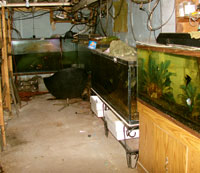
We see some of the author’s larger tanks.My Setup
You’d love my water quality. Your basement would also need eight huge plants hanging and sitting beneath fluorescents. There are 20 aquariums ranging from three 15-gallon tanks to a 220, which weighs 440 pounds empty and more than a ton when full. It took seven of us to get it down here, and it’s never coming out. It’s 30-inches deep, or longer than an arm (mine is 27 inches).
This means you stand on something and “hang in there,” literally. It was the centerpiece in the last rounds of taping at WQLN (Erie, PBS) for the “Guppies to Groupers” shows. Today it houses seven 6-inch koi waiting to return to Camp Notre Dame next summer.
Two years ago, the end of this tank opened up along the vertical seams. It was empty. That is, the koi were away at camp and the water was on the floor. I cleaned the surfaces with a razor and resealed them with silicone.
Aquarium repair is easy. Just do the prep work. That means you need to achieve clean, dry surfaces. Give some thought to applying pressure (that is, applying weight over the sealed joint). Finally, make sure there are no bubbles in the silicone. As insurance I got a pipe clamp (a pipe with adjustable sliding clamps) to hold it while it dried. It’s still on there. You can see it at the end of the cellar.
The two aquariums along the right are the 150s. The dark one is the African tank, without any cichlids. It was in this one that I “discovered” the tapetum, the luminescent eyes.
The nearer tank is a mixed bag of South American cichlids. It contains two 6-inch port cichlids, some blue Acaras, a couple big silver dollars, a foot-long pleco type and the “foreigners,” a small school of giant danios. They’re my mixers — they are never still.
It is this aquarium that I wrote about in 1980, when a foot-long oscar and I had a contest of wills. A rock as big as a grapefruit mysteriously moved about 4 feet. I replaced it and the next day it was moved again. I put it back where I liked it. I hid in the shower stall and watched for an hour until the oscar went to work and pushed it through the gravel to where he liked it. He won. Memories!
Past Experiments
The 55 has some favorites. It contains angels, congo tetras, black tetras (one of my first tropicals — circa 1950), a flying fox, a brush mouth pleco, a striped Raphael and others. The purpose of the setup was to establish a plant experiment. Various sword plants, a few crypts and an odd bunch of hygro were introduced.
The sword plants are all thriving but nothing else is. Experience suggests the crypts may be resting. Alesia, where are you when I need you? The top is covered with duckweed that is continually harvested as food for koi and cichlids.
At one point there was only 5 inches of water in this 55-gallon tank. A few Cryptocoryne affinis were planted in dirt in a deep Pyrex dish. After two years the bicolor leaves of the crypts covered the surface. They didn’t flower but did reproduce vegetatively in a splendid manner. I figured I’d try dirt as Mother Nature came up with that method millions of years ago.
Next to this 55 is the beginning of a 2-by-4 rack (one of three). These 2-by-4s are dimensional, not the pared-down versions of today. This speaks to the age of the rack, as does another aspect of the 40-gallon on the bottom. This setup houses the mixed-bag school of clown loaches and tiger barbs that I wrote about recently. Curiously, roughly half the clown loaches have adapted to feeding upside down. It also houses a pair of albino severum.
My Other Tanks
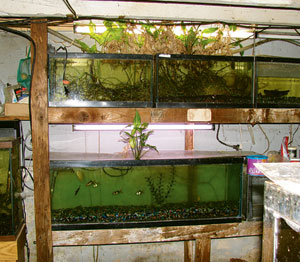
We see the 2-by-4 beams and the now-famous tank filled with a clown loach/tiger barb school.
The rack also holds four 15s. The ones above it are full of a lovely bog plant — Nephthitis or Syngonium — and the roots fill the aquarium. This is a perfect spawning setup with a soup of microscopic life ready for fry food. A second rack at right angle to the one shown holds two 20 longs and two 29s. The third rack is across from the two 150s and holds four 40s.
My third rack got me out of the saltwater game. I had two freestanding marine aquariums, 120 highs, that were “in the way.” The availability of fish had bottomed out locally. There was no reef emphasis in the species the stores were stocking. I broke the setups down, gave the fish and inverts to the Erie Aquarium Society and built another rack to hold four 40s. After 30 years I was without salt.
My first marine aquarium was a Metaframe gold tone 26 flared. Any exposed metal required sealing with black asphaltum. The mix was a thick syrup called Eden Brine. I dabbled for years but was swamped during the “Guppies to Groupers” taping years when 15 of the 46 aquariums in WQLN’s back room were salt. Maybe I’ll get back in the game someday.
The basement has seen some unusual improvisations. A 200-gallon vat was made of lumber and a plastic liner. I raised my barb breeding stock in it and can vividly recall netting t-barbs, mahecolas and black rubys that schooled in it.
A refrigerator liner with glass sealed in the opening cut in the bottom held about 80 gallons — big enough to raise thousands of swords and platys. A memorable experiment was conducted in this vat. I had eight or nine successive yields about a month apart from a 3-inch female red platy without a male present.
I have experimented with every kind of live food that is raised in abundance. Most efforts were rewarding, but the few that backfired were memorable. I built a wooden box, filled it with bran flakes, added a few potato slices for moisture and introduce a culture of grubs.
No one told me their life cycle included beetles that fly (except Lois when they were all over the laundry room). Mosquito larvae are good live food. It is better if they all get eaten (Lois pointed that out, again). All of these pests were “invited.”
Mine is not your average basement, but if yours is like mine, I love you.
‘Til next time.
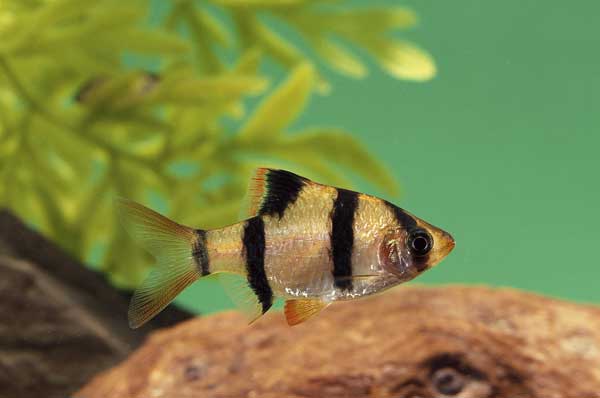 5 Great Freshwater Aquarium Fish
You have your aquarium all set up. The filter has been on fo
5 Great Freshwater Aquarium Fish
You have your aquarium all set up. The filter has been on fo
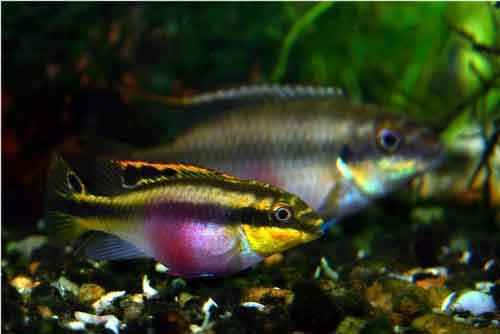 Kribensis Care and Breeding
Kribs are small, colorful cichlids that have become a staple
Kribensis Care and Breeding
Kribs are small, colorful cichlids that have become a staple
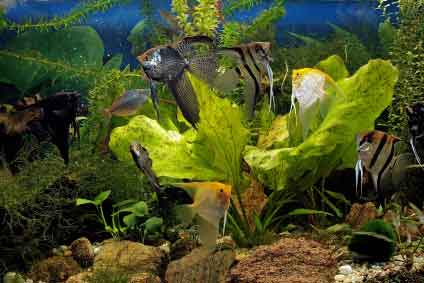 Hiding Fish
A common complaint, especially with new hobbyists, is, &
Hiding Fish
A common complaint, especially with new hobbyists, is, &
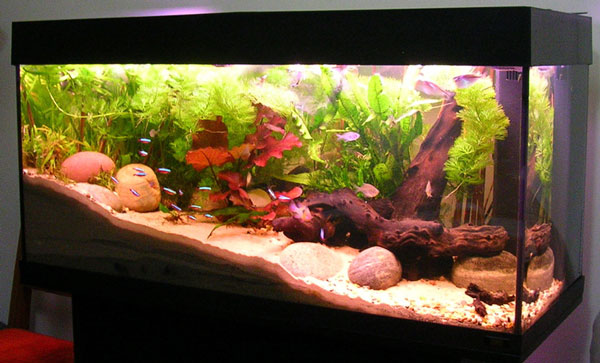 Freshwater Aquarium Beginners Guide
Aquariums are beautiful additions to virtually any living ar
Freshwater Aquarium Beginners Guide
Aquariums are beautiful additions to virtually any living ar
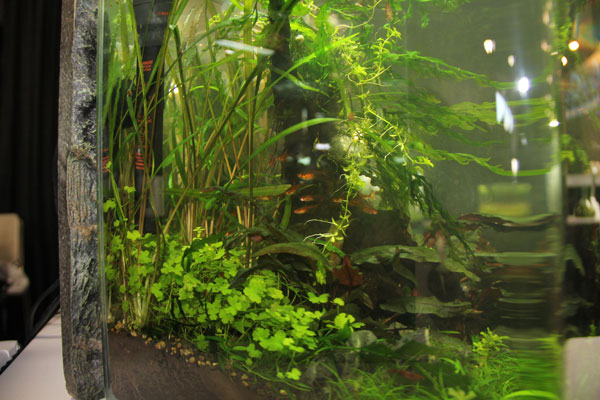 Innovations in the Aquarium Hobby
Fishkeeping has experienced a lot of progress throughout the
Innovations in the Aquarium Hobby
Fishkeeping has experienced a lot of progress throughout the
Copyright © 2005-2016 Pet Information All Rights Reserved
Contact us: www162date@outlook.com